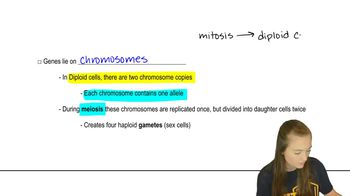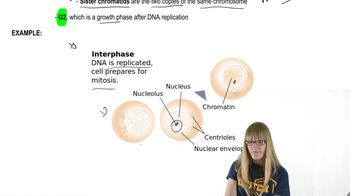Here are the essential concepts you must grasp in order to answer the question correctly.
Diploid Chromosome Number
Diploid organisms, like Drosophila, have two sets of chromosomes, one inherited from each parent. In this case, Drosophila has a diploid number of 2n = 8, meaning it has eight chromosomes in total, including three pairs of autosomes and one pair of sex chromosomes. Understanding diploidy is crucial for analyzing genetic inheritance and allele combinations.
Recommended video:
Alleles and Heterozygosity
Alleles are different versions of a gene that can exist at a specific locus on a chromosome. In the given scenario, the Drosophila male is heterozygous for alleles B₁ and B₂, C₁ and C₂, and D₁ and D₂, meaning it carries two different alleles for each of these genes. This heterozygosity is important for understanding how traits may be expressed in the offspring.
Recommended video:
New Alleles and Migration
Chromosome Alignment in Mitosis
During mitotic metaphase, chromosomes align at the cell's equatorial plane, ensuring that sister chromatids are positioned for equal segregation into daughter cells. In this scenario, the alignment of chromosomes must reflect the specific alleles present on each chromosome and sister chromatid, which is essential for accurate genetic representation and understanding the distribution of alleles during cell division.
Recommended video:






